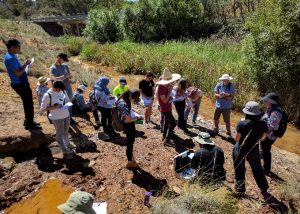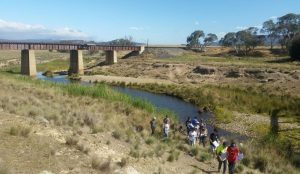On Monday 12 February 2018, the summer ENVS2020/6020 hydrology students set out for Captains Flat: a small town in the Southern Tablelands of rural New South Wales. The aim of the field class was to understand the release of mercury from the tailings and acid mine drainage from the historic Captains Flat mining operation. Runoff from the mine flows directly into the Molonglo River which flows all the way to Lake Burley Griffin (Figure 1)

The township of Captains Flat was formed after the discovery of gold in 1864. The town became a busy centre for mining activity as additional precious minerals including silver, lead, zinc, copper and iron pyrites were unearthed. It had two brief periods of prosperity: the first lasted from 1884-1899 and the second from 1937-1962.
After the mining boom people left the town in great numbers. It has been saved by its proximity to Canberra which makes it an easy day tripper destination with a large pub and relics of the old mine. The town itself is nestled into a valley with the hills around denuded by constant mining. The result is historic buildings and remnants of mining (Figure 2).

Alongside the newfound economic activity and prosperity, came a cost to the surrounding ecosystems. Flooding in 1942 caused widespread contamination of the river resulting from the collapse of tailings and mine waste dams. Approximately 30,000 m3 of tailings were discharged into the Molonglo River and were redistributed across the floodplain downstream and deposited within the channel and across the flood plain.
The tailings brought a range of contaminants including iron and sulphur. Weathering caused by exposure of pyrite (FeS2) in the tailings to water and oxygen generated acidity. This acidity served to mobilise metals. When combined with rainfall, mobilised metals including mercury could be easily disturbed and transported via the runoff down to stream water (Figure 3).

Lake Burley Griffin is one of the most successful aspects of Canberra’s original urban plan, highly valued by the local community for its aesthetic and recreational qualities. It also possesses significant historical, social, and aesthetic values which has entitled the site to Commonwealth Heritage listing.


To assess the environmental risks and impacts of potential mercury contamination, the Water Science students undertook mercury analyses in a gradient from Captains Flat to Lake Burley Griffin. The levels of these contaminants throughout the Molonglo was found to have exceeded the threshold ‘trigger’ values set out by the Australian and New Zealand Guidelines for Fresh and Marine Water (ANZECC, 2000). This finding highlights the need for further investigation into the levels of mercury contaminants throughout our waterways.
This project started as collaboration by scholars and students concerned about the health of the Molonglo Valley and ultimately Lake Burley Griffin. The next step is to investigate the historical mercury concentrations stored in Lake Burley Griffin sediments.
New risks are beginning to emerge with recent developments around the lake, including the construction around Kingston Foreshore leading to the remobilisation of the sediment that may expose the lake to metals deposited many years ago during the mining years. This metal exposure may result in lower water quality and mercury bioaccumulation by organisms that live in the lake like fish and the humans who catch them. Further investigation will shed light on the extent to which this mercury contamination poses a threat to ecological connectivity and the health of Lake Burley Griffin.
This project has been funded through ANU teaching funds.
By Nicholas Metherall and Larissa Schneider


Twitter